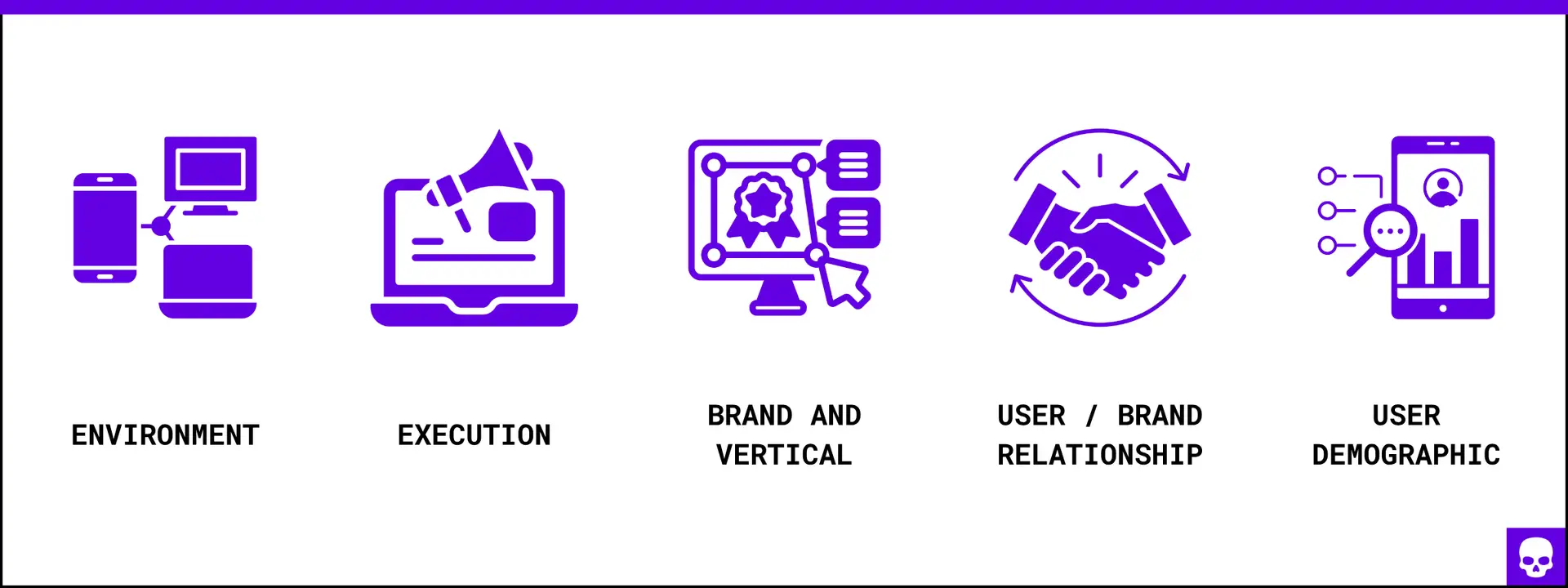Personalised ads* have become a contentious topic within the industry. Beyond the ongoing regulatory battles, there are disagreements about whether they’re actually effective at driving advertising effectiveness. On one hand, we have research, anecdotal evidence, and the intuitive understanding that more relevant ads outperform less relevant ads. On the other, we have passionate op-eds and academic research demonstrating that in certain scenarios, targeted ads not only fail to outperform untargeted ads, but are actually less efficient in achieving desired marketing outcomes.
* In this article, we define “personalised ads” as any form of advertising that uses audience data with the goal of enhancing the relevance of the ad experience for the end user.
So who’s right? As you might expect, the reality isn’t a binary “good” or “bad” or “works” or “doesn’t work”. In my experience, the potential effectiveness of personalised ads hinges on a variety of factors that shape the “context” of the user’s overall ad experience:

ENVIRONMENT – Where did the user receive the ad? This includes everything from the channel, platform and property.
EXECUTION – Did the brand successfully identify the user and if so, where was the ad served, what was the creative, what was the format, and how was it delivered?
BRAND AND VERTICAL – What brand delivered the ad and which vertical does that brand belong to?
BRAND/USER RELATIONSHIP – What’s the user’s relationship with the brand? Are they an existing customer/user?
USER DEMOGRAPHIC – What demographic cohort does the user belong to?
In this post, we’ll walkthough through how these variables can influence the effectiveness of personalised ads by using me as an example. In other words, we’ll examine how each variable affects my personal receptivity to a targeted ad. Of course, this is a n=1 perspective and shouldn’t be generalised to a larger audience. That said, my hope is that it can serve as a useful case study to highlight the different factors that can impact the overall success of a personalised ad.
For clarity, we’ll explore each variable individually. In reality however, most of these intersect to create a specific combination of user expectations and receptivity. This will become clear as we progress through each section. We’ll wrap things up by discussing what this all means for advertisers and their agencies.
Factors shaping a user's personalised ad experience
Environment
Simply put, this refers to where the ad appears. This can include the device, the media channel, the specific site/app, or a combination of these. Within this category, several factors influence whether I’m receptive to and/or expect a personalised ad.
The first (and most important) factor is that I’m far more open to personalised ads in channels where the content itself is personalised. Think social media feeds or eCommerce platforms where content is tailored to my preferences, browsing habits, and interactions. If the content is curated, then I’d expect the ads to follow suit. In a way, personalised ads delivered in a personalised content environment can be considered contextually relevant (if not to the content, then to the user experience) (link out here). This explains why personalised ads tend to outperform non-personalised ads in these types of environments. If the content is tailored based on user behavior, then ads that aren’t can feel out-of-place and incongruent with the overall user experience.
Contrast this with the “general” open internet (e.g. news sites or apps) where content isn’t curated for me in the same way and I have to actively browse to find what I’m looking for. In these environments, I don’t expect ads to be personalised and in some cases, actually prefer that they aren’t. Related to my previous point on personalised ads in personalised content environments being contextually congruent, personalised ads in a non-personalised content environment can have the opposite effect. This is especially true when the execution is poor, such as with lazy, aggressive retargeting that follows me around the web.
Execution
I think about this on two levels:
- Did the brand successfully identify me?
- If so, how is the ad delivery executed
Did the brand successfully identify me?
Here it’s useful to consider the data type the brand is deploying. While I wouldn’t explicitly know the data type a brand is using to reach me, I can make an educated guess based on my relationship with the brand or the environment in which the ad is being served.
3rd party data – If I don’t have an existing relationship with the brand or the platform/property being used to reach me, they’re likely using 3rd party data (3PD). However, most 3PD is so inaccurate that I probably wouldn’t even realise I’m being targeted. If I’m unaware that a brand is trying to hit me with a personalised ad, then I’d consider it an automatic failed execution.
1st and 2nd party data – Here, I either have a direct relationship with the brand or the platform/property being used to reach me. Assuming good data quality (which isn’t always a guarantee), let’s say they’ve successfully addressed me. Now we move onto the next step.
Ad execution
This is where the actual campaign execution comes into play. Factors include but aren’t limited to:
Delivery environments – As discussed earlier, certain channels/platforms/properties are more suited for personalised ads.
Ad creative and messaging – Needless to say, the actual creative itself needs to be on point in order to drive marketing effectiveness.
Ad format – This depends somewhat on the environment, but we all react better to certain formats depending on the message.
Targeting tactic – Follow me around with aggressive retargeting or hit me with an ad too soon after I visit your website? Feels creepy, not good. Do I see the same ad over and over again on YouTube? That’s annoying, also not good. The point is how the ad is delivered significantly impacts how I feel about its message.
The point is that there are countless permutations in personalised ad execution, and we all have preferences that influence our receptivity. It’s worth noting that brands I already have a positive relationship with are somewhat shielded from a negative ad experience impacting my overall sentiment. However, brands without this existing goodwill don’t have the same protection. For example, a persistent, hovering Taco Bell banner on a niche comic book site might be easily dismissed. But the same ad from an unknown brand could lead me to think of less of them.
Brand and Vertical
This refers to the advertising brand and the vertical it belongs to. For brands/verticals that either facilitate repeat purchases (e.g. retail, gaming) or offer inherently personalised products (e.g. financial services, insurance), I expect ads to be at least somewhat relevant to my needs. For instance, I wouldn’t want to be served an ad for women’s formal wear.
In contrast, there are some brands I wouldn’t expect (or even want) personalised ads from. Nike and Apples are two such examples. From Nike, I don’t want a highly specific carousel ad unit showcasing products I’ve browsed on their eCommerce site. I want inspiring hero video ads that motivate me to get out and get moving. From Apple, I expect clever, vibrant, premium out-of-home takeovers, not some generic digital, dynamically retargeted banner. Is this simply what I’ve been conditioned to expect? Could others have different preferences? Absolutely. The point is that different audiences may have varying expectations from brands, all of which can impact receptivity to personalised ads.
User/Brand relationship
Another variable is my existing relationship with the brand (this is separate from the point made on existing brand sentiment in the Ad Execution section). If I’m already a customer or user, I naturally expect them to know more about me and provide a more relevant, personalised ad experience. This expectation increases with my level of brand engagement. The more I use their products or services, the more they should know about me, and the higher my expectations for relevant ads become.
If I’m a frequent user of the brand, my expectations start to cross-over into those of an owned or organic brand experience (like on their website or app). In other words, my expectation becomes less “ad-like” and more akin to brand personalisation at large. There’s ample research demonstrating that users prefer this type of personalisation beyond just ads.
User Demographic
Finally, there’s my demographic profile. This includes my generational cohort, content consumption habits, preferred communication channels, etc. – all which influence my receptivity to not only personalised ads, but advertising in general. Not surprisingly, my preferences differ significantly from those of someone from Gen X of Gen Z.
Occupation can also matter. Having spent my entire career in digital marketing, I’m more aware of how the advertising “sausage” is made than most people. This knowledge shapes my perspective and receptivity to personalised ads in a way that’s different compared to someone outside the indust
Now that we’ve walked through each of the variables, here’s a recap of how each of them can impact my receptivity to personalised ads:
ENVIRONMENT – Am I in an environment where personalised ads feel appropriate and welcome?
EXECUTION – Was I accurately identified? If so, was the ad executed in a tasteful way?
BRAND AND VERTICAL – Is the brand and/or vertical a good fit for personalised advertising?
USER/BRAND RELATIONSHIP – Does my relationship with the brand warrant a personalised ad experience?
USER DEMOGRAPHIC – How does my demographic profile and media consumption habit/preferences affect my overall openness to personalised ads?
We’ll wrap things up by discussing what all this means for marketers and their agencies.
Implications for advertisers
To maximise the potential effectiveness of personalised ads, sophisticated marketers and their agencies should take into account our discussed variables when planning campaigns that feature audience-targeted, personalised ads.
Furthermore, advertisers must carefully weigh the costs of personalised ads and ensure the projected performance uplift justifies the higher expense relative to untargeted ads. Here are some considerations for different data types:
- When using 1st party data, consider the target audience’s niche appeal. Less competition for the audience typically means a lower CPM premium in both direct and auction-based ad environments.
- If sourcing 2nd party data from a direct partner, determine if there’s an associated CPM premium.
- In the very rare cases where 3rd party data is justified, factor in the significant CPM premium it usually commands.
All of this requires close collaboration between planning and data science/forecasting teams, combining quantitative data with qualitative brand and domain expertise to ensure the plan is sound.
Does this sound challenging? Time-consuming? You bet it is. And it’s supposed to be.
While the industry (and technology in general) is moving towards automation and abstracting away complexity, effective marketing is still about connecting with and winning the hearts and minds of your target audience. These are real people, and people are complex, nuanced and full of shades of grey. Good marketers can empathise with their audience while blending the art and science of modern marketing. As long as that’s true, there will likely always be an aspect that can’t be fully automated or replaced by AI, no matter what some may claim.



